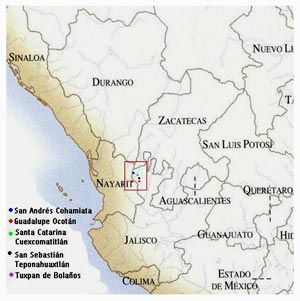
| FAMSI © 2007: Víctor Manuel Téllez Lozano |
||
The Reorganization of the Huichol Ceremonial Precinct (Tukipa) of Guadalupe Ocotán, Nayarit, México
Research Year: 2005 Table of Contents
Abstract This report summarizes the results of research undertaken in Guadalupe Ocotán, a dependency and agrarian community located in the municipality of La Yesca, Nayarit. This study explores in greater depth the political and ceremonial relations that existed between the ceremonial district of Xatsitsarie and San Andrés Cohamiata, one of three Wixaritari (Huichol) communities in the area of the Chapalagana River, in the northern area of the state of Jalisco (Figure 1, shown above). Moreover, it analyzes how the destruction of the Temple (Tuki) of Guadalupe Ocotán, together with the modification of the community's territory, determined the collapse of these ceremonial links in the second half of the 20th century. The ceremonial reorganization of this district is analyzed using a diachronic perspective, in which the ethnographic record, which begins with Lumholtz' work in the late 19th century, is contrasted with reports by missionaries and oral history. Similarly, on the basis of ethnographic data and information provided by archaeological studies, this study offers a reinterpretation of certain ethnohistorical sources related to the antecedents of these ceremonial centers. Este reporte resume los resultados de la investigación realizada en la Guadalupe Ocotán, una gobernancia y comunidad agraria ubicada en el municipio de La Yesca, Nayarit. Este trabajo ha profundizado en las relaciones políticas y ceremoniales que existieron entre el distrito ceremonial de Xatsitsarie y San Andrés Cohamiata, una de las tres comunidades Wixaritari (huicholas) ubicadas en la zona del río Chapalagana, al norte del estado de Jalisco (Figura 1, mostrada arriba). De igual modo, analiza la forma en que la destrucción del Templo (Tuki) de Guadalupe Ocotán, así como la modificación del territorio comunitario, determinó el colapso de estos nexos ceremoniales en la segunda mitad del siglo XX. La reorganización ceremonial de este distrito es analizada desde una perspectiva diacrónica, en que el registro etnográfico, iniciado por Lumholtz a finales del siglo XIX, es contrastado con los reportes de los misioneros y la historia oral. De igual modo, a partir de la etnografía y la información proporcionada por los estudios arqueológicos, presenta una reinterpretación de algunas fuentes etnohistóricas sobre los antecedentes de estos recintos ceremoniales. For writing words in the Wixarika (or Huichol) language I have used the alphabet developed by the Department of Studies of Indian Languages of the University of Guadalajara, which is based on the pioneering work of Grimes and MacIntosh. This alphabet consists of five vocals: a, e, i, ɨ, u. With the exception of /ɨ/, which has a sound between /i/ and /u/, the rest of the vowels are pronounced the same as in Spanish. There are thirteen consonants: voiceless stop: /p/, /t/, /k/, /kw/, /'/; voiceless fricative: /h/; voiceless affricate: /ts/; nasal: /m/, /n/; tap or flap (Vibrante simple): /r/; trill (Vibrante múltiple): /x/; voiced semivowel: /w/, /y/. The Wixarika language has several ways to express plurality, for instance the word Wixarika defines this ethnic group and its territory, while the word Wixaritari is used to define a group of people, or communities. The words Tuki and Xiriki, which define the ceremonial precincts analyzed in this study, become plural if the particle te: is added, for instance: Tukite, Xirikite. The word Tukipa refers to a ceremonial complex composed of a Tuki, a patio and one or more Xirikite. The ceremonial offices of Kawiteru and Mara'akame are pluralized thus: Kawiterutsixi and Mara'akate. Click to download the report in PDF format: The Reorganization of the Huichol Ceremonial Precinct (Tukipa) of Guadalupe Ocotán, Nayarit, México (3.72 MB) The PDF files require Adobe Acrobat Reader.
Submitted 03/22/2006 by: |
||
|
Text links to all pages at this site are available at the FAMSI INDEX |
||

